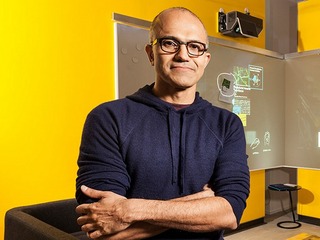Pitchbook survey: VCs see AI as high growth but also overinvested
The biggest focus areas for AI investing are healthcare and biotech
Read more...
Last week, Microsoft CEO Satya Nadella made what I’m legally obligated to call a “gaffe.” During a fireside chat with Microsoft board member Maria Klawe at the Grace Hopper Celebration of Women in Computing, Nadella said that women should not ask for raises, but should rely on karma (read: managerial whims). He’s been backpedaling ever since, first with a tweet, then with an official statement. This week, it’s an internal memo.
The memo leaked late Thursday and in it, Nadella apologizes once more and reiterates that his on-stage response was wrong, calling it a “humbling and learning experience.”
To recap, Klawe asked Nadella what advice he would give to women who are uncomfortable asking for a raise. Nadella’s response was magnificently uninformed.
“It’s not really about asking for the raise, but knowing and having faith that the system will actually give you the right raises as you go along. And that, I think, might be one of the additional superpowers that quite frankly women who don’t ask for a raise have. Because that’s good karma. It’ll come back, because somebody’s going to know that’s the kind of person that I want to trust. That’s the kind of person that I want to really give more responsibility to.”
Karma seems to be doing a pretty shitty job on its own, considering that U.S. women earned just 78% of what U.S. men were paid in 2013. Studies show that this is due, in small part, to the fact that women tend to be more reluctant to negotiate for a higher wage during the initial interview process, and they tend to be reticent to ask for a raise later on.
About 40% of the gender pay gap can be attributed to flat out discrimination. So evidently, Karma is a sexist jerk.
Nadella immediately sent out a tweet after the interview to explain that he was “inarticulate.” That was followed by a full-on apology.
To be fair, I don’t think Nadella is a misogynist, or that he said what he did as some kind of veiled threat to female employees to stay in their place (as some have seen it). What we have here is simply another good fellow caught up in the myth of the meritocracy.
Earlier this month, Microsoft released its diversity report, in which it revealed that 29% of its employees are women. When it comes to tech jobs, however, that number drops to a paltry 17.1%. Nadella acknowledges that that is where the company is failing women.
The full text of Nadella’s memo, via GeekWire, is below:
In today’s monthly Q&A session, I want to give some perspective about the past few weeks — my trip to Asia , Gartner Symposium, the Adobe MAX conference, the Grace Hopper conference and Windows 10, as well as focus on Diversity and Inclusion (D&I) (and, of course, anything else on your minds). In November we’ll have a tightly focused conversation with Terry about Windows 10 more broadly.
Before our discussion, I want to provide additional thoughts from the Grace Hopper conference last week. Thank you to the many people who sent me comments and feedback over the past few days. It was a humbling and learning experience.
One of the answers I gave at the conference was generic advice that was just plain wrong. I apologize. For context, I had received this advice from my mentors and followed it in my own career. I do believe that at Microsoft in general good work is rewarded, and I have seen it many times here. But my advice underestimated exclusion and bias — conscious and unconscious — that can hold people back. Any advice that advocates passivity in the face of bias is wrong. Leaders need to act and shape the culture to root out biases and create an environment where everyone can effectively advocate for themselves.
Make no mistake: I am 100 percent committed to Diversity and Inclusion at the core of our culture and company. Microsoft has to be a great place to work for everybody. I deeply desire a vibrant culture of inclusion. I envision a company composed of more diverse talent. I envision more diverse executive staff and a more diverse Senior Leadership Team. Most of all, I envision a company that builds products that an expansive set of diverse and global customers love. As we make Diversity and Inclusion central to Microsoft’s business, we have the opportunity to spark change across the industry as well. This is the accountability the Senior Leadership Team and I own.
There are three areas in which we can and will make progress — starting immediately.
First, we need to continue to focus on equal pay for equal work and equal opportunity for equal work. Many employees have asked if they are paid on par with others at the company. Here’s what HR confirmed for me: Although it fluctuates by a bit each year, the overall differences in base pay among genders and races (when we consider level and job title) is consistently within 0.5% at Microsoft. For example, last year women in the US at the same title and level earned 99.7% of what men earned at the same title and level. In any given year, any particular group may be slightly above or slightly below 100 percent. But this obscures an important point: We must ensure not only that everyone receives equal pay for equal work, but that they have the opportunity to do equal work.
Second, we need to recruit more diverse talent to Microsoft at all levels of the company. As you saw in the numbers we recently released, we have work to do at Microsoft and across the industry. These numbers are not good enough, especially in a world in which our customers are diverse and global. To achieve this goal — and especially in engineering — we will have to expand the diversity of our workforce at the senior ranks and re-double our efforts in college and other hiring. Each member of the SLT will be goaled to increase Diversity and Inclusion.
Third, we need to expand training for all employees on how to foster an inclusive culture. Although we already offer training and development in these areas, we need to ensure the right level of accountability for modeling inclusive behaviors in all our work and actions. We all need to think about how Connects are written, performance feedback is delivered, new hires are selected, how promotion and pay decisions are made, etc. We need to focus on both the conscious and unconscious thinking that affects all these things, and mandatory training on D&I is a great place to start.
I am personally fully committed to these efforts and so is the rest of the Senior Leadership Team. We are going to work side by side with Gwen Houston, GM, Diversity and Inclusion, each month to drive progress on the three actions above, and Gwen and her team will continue to gather input, refine our existing plans and develop new approaches. I’ll report back to you in future all employee Q&A sessions starting in November.
When I took on my role as CEO I got advice to be bold and be right. Going to the Grace Hopper conference to further the discussion on women in technology was bold, yet my answer to a key question was not right. I learned, and we will together use this learning to galvanize the company for positive change. And I’ll certainly go back to Grace Hopper next year to continue the dialogue. We will make Microsoft an even better place to work and do great things.
Satya
Image source: dailytech.com
The biggest focus areas for AI investing are healthcare and biotech
Read more...It will complete and submit forms, and integrate with state benefit systems
Read more...The bill would require a report on how these industries use AI to valuate homes and underwrite loans
Read more...

